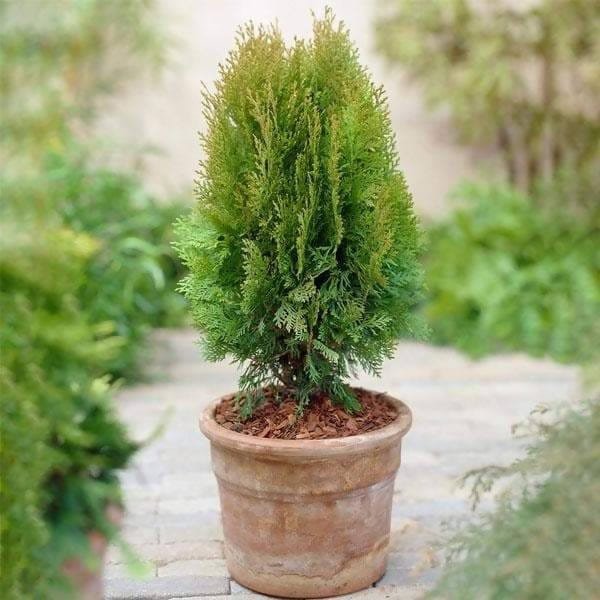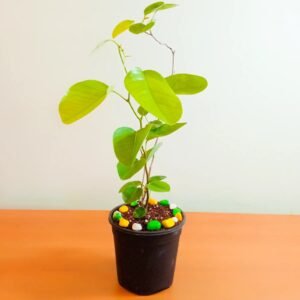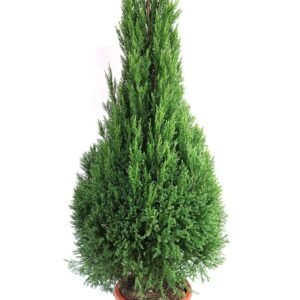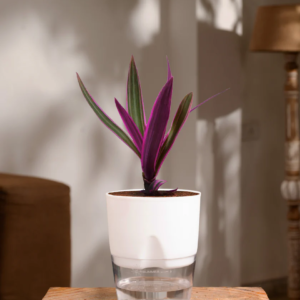Description
Golden Morpankhi Plant (Thuja orientalis ‘Aurea Nana’) – A Complete Description
The Golden Morpankhi plant, a dazzling gem in the world of ornamental horticulture, is prized for its vibrant golden foliage, evergreen nature, and elegant, conical shape. Belonging to the cypress family Cupressaceae, this plant is also scientifically known as Thuja orientalis or Platycladus orientalis. The word “Morpankhi” comes from the Hindi language and translates to “like a peacock feather,” referencing the plant’s feathery, fan-like leaves that resemble the fine structure of a peacock’s plume. The golden variety—Golden Morpankhi—is particularly sought after for its decorative appeal in both indoor and outdoor settings.
Botanical Classification
- Common Name: Golden Morpankhi, Golden Cypress, Golden Thuja
- Scientific Name: Thuja orientalis ‘Aurea Nana’
- Family: Cupressaceae
- Origin: Native to parts of Asia, particularly China and Korea
- Type: Evergreen coniferous shrub
Physical Description
The Golden Morpankhi plant is a compact, slow-growing conifer that forms a dense, pyramidal or conical shape. It typically reaches a height of 3 to 6 feet when grown in pots or gardens, although it can grow taller in favorable conditions.
- Foliage: The plant’s most distinguishing feature is its bright yellow-golden foliage, which remains vibrant throughout the year. The leaves are scale-like and grow in flat, fan-shaped sprays. The golden hue is especially intense in young growth and during spring.
- Shape: It has a naturally symmetrical form, making it a favorite for formal landscaping and topiary.
- Bark and Stems: The bark is reddish-brown and fibrous, adding subtle texture to the plant’s aesthetic.
- Flowers and Fruits: It produces small, inconspicuous cones which are often overlooked due to the prominence of its foliage. These cones are about 1-2 cm long and mature to a brown color.
Growth and Cultivation
Golden Morpankhi is known for its easy maintenance and adaptability, making it suitable for both beginner gardeners and experienced landscapers.
Ideal Conditions
- Light: Prefers full sun to partial shade. At least 4-6 hours of direct sunlight helps retain the golden color of the foliage.
- Soil: Grows well in well-drained, loamy to sandy soil. Slightly acidic to neutral pH is ideal.
- Watering: Requires moderate watering. Overwatering can lead to root rot, while prolonged drought can cause browning of the leaves.
- Temperature: Tolerant to a wide range of temperatures but thrives best in temperate to subtropical climates. It can handle light frost but not severe freezing.
- Humidity: Adapts well to both dry and moderately humid conditions.
Propagation
- Typically propagated through cuttings rather than seeds. Semi-hardwood cuttings taken in the monsoon or early spring have a high success rate.
Fertilization
- A balanced slow-release fertilizer during spring supports healthy growth. Avoid high nitrogen content as it may encourage lanky growth and reduce foliage density.
Pruning
- Regular pruning helps maintain the shape and promotes bushier growth. It responds well to trimming, making it suitable for topiary and hedge design.
Uses and Landscaping Applications
Golden Morpankhi’s aesthetic and functional versatility makes it popular across residential and commercial landscaping projects.
Decorative Uses
- Hedges and Borders: Planted closely, it forms a dense hedge that provides privacy and wind protection.
- Specimen Planting: Serves as a focal point in rock gardens, lawns, or patios.
- Potted Plant: Often used in pots on terraces and balconies for a formal, manicured look.
- Topiary Art: Its dense foliage and slow growth make it ideal for shaping into artistic forms.
Functional Uses
- Windbreaks and Screens: Can be used to block strong winds or unsightly views.
- Air Purification: Like many evergreens, it helps improve air quality by absorbing pollutants.
Benefits of Golden Morpankhi
Aesthetic Appeal
- The golden-yellow foliage provides a lively contrast against green plants and dark structures, creating visual interest throughout the year.
Low Maintenance
- Requires minimal care once established, making it suitable for busy homeowners or those with limited gardening experience.
Evergreen Nature
- Maintains its foliage and color year-round, unlike many deciduous shrubs that go bare in winter.
Improves Feng Shui and Vastu
- In Feng Shui and Vastu Shastra, the Golden Morpankhi is considered a symbol of prosperity and good fortune. It is often placed near the entrance of homes or businesses to attract positive energy.
Symbolism and Cultural Significance
Golden Morpankhi holds symbolic importance in various cultures, particularly in South Asia:
- Spiritual Meaning: The evergreen nature of the plant represents eternal life and resilience.
- Symbol of Prosperity: The golden color is often associated with wealth, luck, and success in Indian traditions.
- Religious Use: Sometimes used in temple landscaping due to its sacred and serene appearance.
Common Issues and Solutions
Although generally hardy, the Golden Morpankhi can face some issues if not cared for properly.
- Browning of Leaves: This may occur due to underwatering, poor drainage, or root damage. Ensure consistent moisture and avoid soggy soil.
- Pests: Susceptible to aphids, spider mites, and fungal infections in overly humid environments. Neem oil or insecticidal soap can help control these problems.
- Yellowing Leaves (Beyond Natural Golden Color): Can indicate a nutrient deficiency or poor soil quality. Test soil and supplement as needed.
Tips for Healthy Growth
- Rotate Pots: If grown in containers, rotate periodically so all sides receive sunlight.
- Use Mulch: Helps retain moisture and regulate soil temperature.
- Repot Every 2-3 Years: If potted, replant to a slightly larger container with fresh soil to avoid root-bound conditions.
- Avoid Overwatering: Allow the top inch of soil to dry out between watering sessions.
Conclusion
The Golden Morpankhi plant is more than just an ornamental shrub—it’s a symbol of beauty, longevity, and prosperity. With its dazzling foliage and low-maintenance needs, it brings structure and color to any garden or indoor space. Whether you’re a seasoned landscaper or a novice gardener, incorporating this plant into your surroundings is a choice that combines elegance with ecological benefit.







 3 Layer Lucky Bamboo Plant in a Bowl with Pebbles
3 Layer Lucky Bamboo Plant in a Bowl with Pebbles  Combo of 2 Vermicompost and Cocopeat to Make Soil Nutrient Rich and Porous
Combo of 2 Vermicompost and Cocopeat to Make Soil Nutrient Rich and Porous  Marvelous indoor plants on solid metal stand for indirect light
Marvelous indoor plants on solid metal stand for indirect light  Ficus Bonsai - Plant
Ficus Bonsai - Plant  2 Layer Lucky Bamboo Plant in a Bowl with Pebbles
2 Layer Lucky Bamboo Plant in a Bowl with Pebbles  Birthday Wishes with Peace Lily Plant
Birthday Wishes with Peace Lily Plant  Nutrient-rich general purpose potting soil mix - 5 kg
Nutrient-rich general purpose potting soil mix - 5 kg  Ficus Lyrata Bambino, Dwarf Fiddle Leaf Fig - Plant
Ficus Lyrata Bambino, Dwarf Fiddle Leaf Fig - Plant  plant Combo of 2 Layer and 3 Layer Lucky Bamboo Plants in a Glass Vase with Pebbles
plant Combo of 2 Layer and 3 Layer Lucky Bamboo Plants in a Glass Vase with Pebbles  Set of 5 Enchanting Roses
Set of 5 Enchanting Roses  Amazing plants on metal stand for indirect light receiving home space
Amazing plants on metal stand for indirect light receiving home space  Pomegranate, Annar, Anar - Plant
Pomegranate, Annar, Anar - Plant  Rhoeo Tricolor Plant
Rhoeo Tricolor Plant  Areca Palm (Small) - Plant
Areca Palm (Small) - Plant  Coriander Panipat - Desi Vegetable Seeds
Coriander Panipat - Desi Vegetable Seeds  Set of 3 Outdoor Flowering Plants for Beautiful Garden
Set of 3 Outdoor Flowering Plants for Beautiful Garden  Elephant bush, Portulacaria afra, Jade plant (Green) - Succulent Plant
Elephant bush, Portulacaria afra, Jade plant (Green) - Succulent Plant  Zinnia Dahlia Mixed Color - Desi Flower Seeds
Zinnia Dahlia Mixed Color - Desi Flower Seeds  Jasminum sambac, Mogra, Arabian Jasmine - Plant
Jasminum sambac, Mogra, Arabian Jasmine - Plant  LEMON GRASS-PLANT
LEMON GRASS-PLANT 

Reviews
There are no reviews yet.